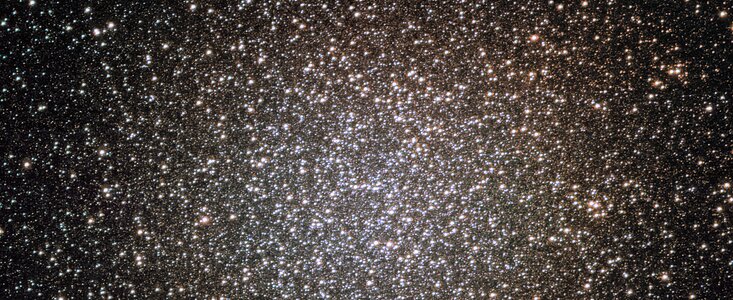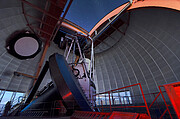NEWFIRM Imager Returns to NOIRLab in Chile, Captures Omega Centauri Globular Cluster
Powerful near-infrared imager will support multi-messenger astronomy research
28 March 2023
NEWFIRM, a high-resolution, near-infrared imager with a wide field of view, has completed its commissioning run on the Víctor M. Blanco 4-meter Telescope at Cerro Tololo Inter-American Observatory (CTIO) in Chile, a Program of NSF NOIRLab. During its commissioning and capabilities testing, astronomers used NEWFIRM to capture a detailed image of the Omega Centauri globular cluster.
At about 17,000 light-years from Earth in the direction of the constellation Centaurus, Omega Centauri is the largest globular cluster in the Milky Way, containing approximately 10 million stars, making it a popular target for observations.
This observing run marks NEWFIRM’s second tenure at CTIO. Prior to returning to Chile, NEWFIRM was installed on the Nicholas U. Mayall Telescope at Kitt Peak National Observatory (KPNO) in Arizona, also a Program of NOIRLab, for observing runs in 2006–2010 and 2012–2016. It was previously installed on the Blanco telescope in 2010–2011.
Prior to re-installation, NEWFIRM was upgraded with new software, control hardware, guiders, computers, and interfaces, thanks to a competitive NSF grant in support of projects promoting multi-messenger astronomy.
Specifically, NEWFIRM will be used to search directly for near-infrared counterparts of gravitational-wave events. It also will conduct follow-up investigations of time-domain events detected by Vera C. Rubin Observatory, which is currently under construction in Chile.
A wide-field and high-resolution near-infrared imager, NEWFIRM is designed to be a major force in support of multi-messenger astronomy and of Vera C. Rubin Observatory in general, complementing the US Department of Energy-fabricated Dark Energy Camera (DECam) at the prime focus of the Blanco telescope.
Eventually, NEWFIRM will also become part of the Astronomical Event Observatory Network (AEON), along with DECam.
More information
NSF NOIRLab (National Optical-Infrared Astronomy Research Laboratory), the US center for ground-based optical-infrared astronomy, operates the International Gemini Observatory (a facility of NSF, NRC–Canada, ANID–Chile, MCTIC–Brazil, MINCyT–Argentina, and KASI–Republic of Korea), Kitt Peak National Observatory (KPNO), Cerro Tololo Inter-American Observatory (CTIO), the Community Science and Data Center (CSDC), and Vera C. Rubin Observatory (operated in cooperation with the Department of Energy’s SLAC National Accelerator Laboratory). It is managed by the Association of Universities for Research in Astronomy (AURA) under a cooperative agreement with NSF and is headquartered in Tucson, Arizona. The astronomical community is honored to have the opportunity to conduct astronomical research on Iolkam Du’ag (Kitt Peak) in Arizona, on Maunakea in Hawai‘i, and on Cerro Tololo and Cerro Pachón in Chile. We recognize and acknowledge the very significant cultural role and reverence that these sites have to the Tohono O'odham Nation, to the Native Hawaiian community, and to the local communities in Chile, respectively.
Links
Contacts
Alistair Walker
Astronomer and Dark Energy Camera Instrument Scientist
NSF NOIRLab
Email: alistair.walker@noirlab.edu
Charles Blue
Public Information Officer
NSF NOIRLab
T: +1 202 236 6324
Email: charles.blue@noirlab.edu



